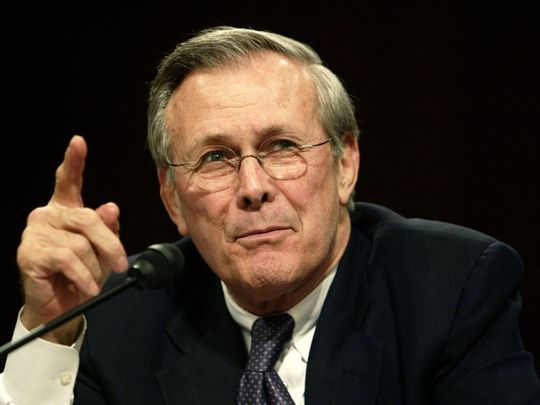
In his memoirs ‘Known and Unknown’, published in 2011, Donald Rumsfeld says that the US responses to all terrorist attacks have not been adequate. He thought those who dared to attack the US interest, even on American territory, have managed to get away with murder.
As he became George W. Bush’s Defence Secretary on January 20, 2001, eight months before the September 11 terror attack on New York and Washington, Rumsfeld, a veteran of three previous Republican administrations, seized on the opportunity to “fix” those historic mistakes.
Rumsfeld, who died last Tuesday, is best known as the architect of the invasion of Iraq in 2003, considered as one of the most disastrous foreign policy decisions in US history. In his book, he says that when ‘terrorists’ hit the US again and again, subsequent administrations failed to retaliate in a proper way, thus may have indirectly encouraged other terrorists.
He cites the 1988 Lockerbie, Scotland plane explosion; the 1993 World Trade Center bombing; the 1996 Khobar Towers attack against US military personnel in Saudi Arabia; the 1998 US embassy bombings in Africa; and finally, the 2000 attack on the military ship USS Cole in the Gulf of Eden.
Going for the overkill
As the highjacked planes hit New York that fateful morning on September 11, 2001, Rumsfeld, forever the hawkish warrior, must have instantly thought, as he watched the twin towers crumble, that this was his moment - to ensure that terrorists no longer get away with attacking America.
This time the US must not just launch customary retaliatory airstrikes. No, not under his watch. The punishment this time must be an overkill. The US must overdo it, he decided then. Not less than an invasion, and if possible, an occupation of Afghanistan, where Osama Bin Laden was based. But then and out of thin air, Iraq came into the conversation.
Here, Rumsfeld’s memory seems ‘sketchy’ as he tries to pin the responsibility of the catastrophic Iraq invasion on President Bush. He claimed that invading Iraq was Bush’s idea, which he first broached to Rumsfeld on September 26 - a fortnight after 9/11.
But multiple sources, including Washington Post writer Bob Woodward and even Rumsfeld's biographer Bradley Graham says that is a lie. They confirmed that “within hours” after the attacks, Rumsfeld told Joint Chief of Staff Chairman General Richard Myers that the US should consider “striking Osama Bin Laden and Saddam Hussein.”
The next day, in a meeting of Bush’s war cabinet, Woodward and Graham note, Rumsfeld asked if the September 11 attacks “offered an opportunity to attack Iraq.” Bush, in his memoirs ‘Decision Points’, recalls a September 15 meeting at Camp David in which Rumsfeld said that “Dealing with Iraq would show a major commitment to antiterrorism.”
The rest is history or not quite - as the process of the destruction of Iraq continues until today. The 2003 invasion was disastrous in every sense and on all levels.
Rumsfeld tried hard in his memoir to absolve himself of any responsibility blaming as always incompetent others — this time a ‘reluctant’ Secretary of State Collin Powell, ‘arrogant’ National Security Advisor Condoleezza Rice and the ‘insubordinate’ ‘and often ‘reckless’ Paul Bremmer. The idea of invading Iraq was his. He led and oversaw the overwhelming military operations that destroyed all of Iraq.
Saddam’s ‘friend’ in the 80s
For most of the Iraqis, this not the first time Rumsfeld oversaw the destruction of their country. In 1983, when Iraq was in the middle of the war with Iran, he dropped unannounced in Baghdad to assure his ‘friend’ Saddam Hussein that the US stood with Iraq.
His famous picture shaking hands with Saddam was posted on social media by countless Iraqi accounts as the news of Rumsfeld’s death broke. A weaker Saddam at that time may have decided to end the war, many Iraqis commented.
But the war dragged on for five more years after that historic visit by Rumsfeld, who was dispatched by the former president Ronald Reagan to establish ties with Baghdad and offer military, financial and political support to the Iraqi dictator.
According to a White House document signed by President Reagan on November 26, 1983, the sole US interest in the Gulf region was to ensure the smooth movement of oil towards the West.
Iran and Iraq were at the time targeting each other’s oil facilities in the Gulf, often leading to a disruption in oil shipping and spike in oil prices.
The US decided that Saddam would refrain from attacking oil ships in exchange for US military support. But that led to further prolonging the war till 1988. And Rumsfeld was there too, to make sure things went as ‘planned’.
Rumsfeld, who continued to lie about his role in the invasion until the last breath, tried very hard to project an image of a loyal officer, one who implement policies set by his superior. He told night show host Stephen Colbert that he wasn’t a policymaker.
“The president sets the policy. I implement it.” All those who know anything about George W Bush ‘setting policies’, know very well this too is a lie.
Thankfully, history will look with disdain to men like Rumsfeld who destroyed Iraq completely, not once but twice.







